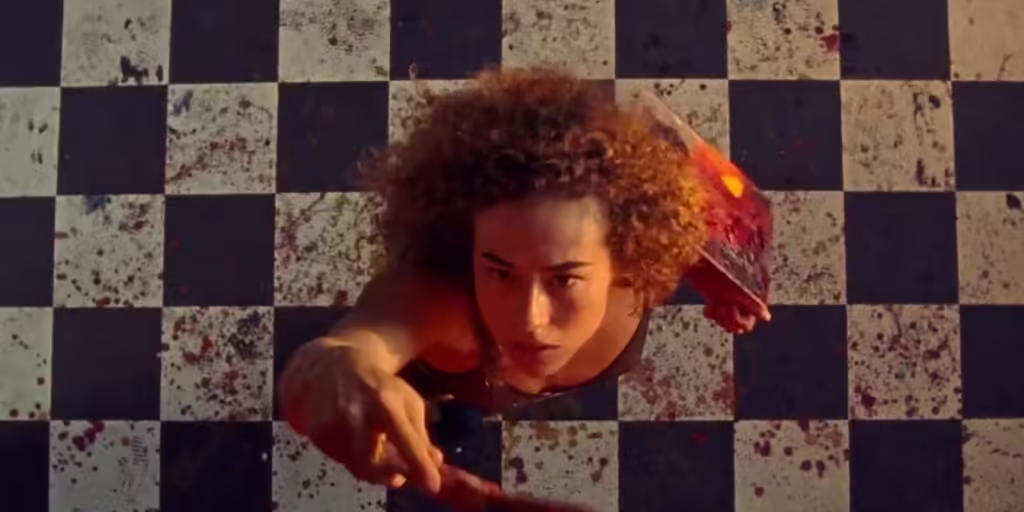Joe Begos’ 2019 film Bliss is a wild, visceral dive into the world of body horror, combining grungy aesthetics with mind-bending cosmic terror. The film stars Dora Madison as Dezzy, a struggling Los Angeles artist who, after breaking her sobriety, embarks on a frenzied bender that sends her spiraling into drug-fueled madness and gruesome bloodshed. With a psychedelic soundtrack, disorienting visuals, and explosive body horror sequences, Bliss crafts an electrifying journey that leaves the audience questioning reality, much like its lead character.
The Plot: Drugs, Blood, and Surreal Visions
Bliss follows Dezzy, an artist whose creative block has stalled her career. In a desperate attempt to finish her latest painting, she turns to a powerful new drug called “bliss,” which ignites her creative spark—but at a deadly cost. As Dezzy parties through Los Angeles’ underground scene, her drug use intensifies, and she begins to experience terrifying visions. Covered in blood, she wakes up with no memory of her nights, realizing that her thirst for art has turned into a thirst for blood.
The movie expertly blurs the line between reality and hallucination as Dezzy’s journey escalates into something far more sinister. What begins as an attempt to reclaim her artistic identity turns into a descent into cosmic horror as Dezzy’s drug-fueled haze opens a portal to otherworldly forces.
Campy 1970s Aesthetic Meets Cosmic Body Horror
Bliss borrows heavily from the aesthetics of 1970s sexploitation films and body horror classics, blending stylized gore with surrealist overtones. Dezzy’s transformation from artist to bloodthirsty predator is accompanied by increasingly violent scenes, where the film’s campy and exaggerated gore stands out. From throats being ripped out to bodies melting like wax, the movie leans into its horror roots with flair.
The over-the-top gore is complemented by Bliss‘ vibrant color scheme, favoring neon reds, purples, and blues that reflect Dezzy’s chaotic mental state. The electric, pulsating lights of Los Angeles’ party scene and the eerie red glow of Dezzy’s candlelit apartment set an otherworldly mood that enhances the movie’s sense of cosmic horror. These visual cues push Bliss beyond typical horror fare, making it an artistic and sensory experience.
A Trippy, Surrealist Editing Style
One of Bliss’ most striking elements is its surrealist editing. As Dezzy’s grip on reality slips, the editing style becomes fragmented and chaotic, mimicking the disorienting effects of her drug use. Quick cuts flash between scenes of her working on her painting, partying, and committing acts of violence, often leaving the audience as disoriented as Dezzy herself.
The painting sequences, in particular, are cleverly intercut with wild party scenes and disturbing hallucinations, showing the transformation of Dezzy’s artwork from a simple sunset to a horrifying hellscape. As she paints, the lines between her inner turmoil and the physical world around her blur, leading viewers to question what’s real and what’s a hallucination.
The use of a fishbowl lens during moments of panic further distorts reality, creating a warped, claustrophobic feeling that mirrors Dezzy’s psychological descent. This disorienting style, paired with the film’s explosive visuals and heavy editing, turns Bliss into a hallucinatory trip that keeps the audience on edge.
The Cosmic Horror: Painting the Apocalypse
At its core, Bliss is more than just a drug-fueled nightmare—it taps into cosmic horror, as Dezzy’s reckless pursuit of artistic perfection begins to unravel the fabric of reality itself. As she becomes more consumed by the drug and her violent cravings, Dezzy unwittingly opens a window into Hell, painting a vision of cosmic terror that feels beyond her control.
This connection to cosmic horror amplifies the feeling of helplessness and dread, as Dezzy’s loss of self mirrors the collapse of reality around her. The gradual transformation of her painting into a nightmarish vision serves as a metaphor for her descent into madness, blurring the lines between the creative process and self-destruction.
A Psychedelic Soundtrack to Match the Madness
Bliss wouldn’t be complete without its incredible soundtrack, featuring electric rock and alternative metal tracks that perfectly underscore Dezzy’s chaotic journey. The heavy guitar riffs and pulsating beats complement the film’s psychedelic visuals, creating a sonic experience that matches the movie’s cosmic and hallucinatory themes.
The underground music scene portrayed in the film feels authentic and gritty, with the soundtrack amplifying the sense of unreality and cosmic horror that unfolds. Combined with the spinning camera angles, quick cuts, and vibrant colors, the music makes Bliss an overwhelming sensory experience.
A Visually Exciting Ride into Madness
Bliss is a film that prioritizes aesthetics, using bold visuals, surreal editing, and a killer soundtrack to craft a sensory experience unlike any other. The film’s blend of body horror, cosmic terror, and surrealist filmmaking results in an electric, visually exciting ride that leaves viewers questioning the reality of what they’ve just witnessed.
While Bliss may not deliver the typical jump scares or gritty realism of modern horror, it more than makes up for it with its unique visual style and trippy, disorienting atmosphere. For anyone looking for a mind-bending horror experience that simulates the chaos of a drug-induced high, Bliss is the movie to watch.
If you’re ready for a 90-minute trip into cosmic horror, body disintegration, and a psychedelic Los Angeles nightmare, Bliss is guaranteed to take you on a journey you won’t forget.
